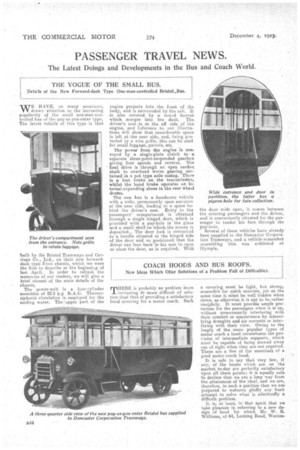COACH HOODS AND BUS ROOFS.
Page 28

Page 29

If you've noticed an error in this article please click here to report it so we can fix it.
New Ideas Which Offer Solutions of a Problem Full of Difficulties.
MHERE is probably no problem inure intriguing dr more difficult of solution than that. of providing a satisfactory hood covering for a motor coach. Such
a covering must be light, but strong, accessible for quick erection, yet at the same time it must be well hidden when down, as otherwise it is apt to be rather unsightly. It must provide ample protection for the passengers when it is up, without unnecessarily interfering with their comfort or convenience by intensifying draughts and air currents or interfering with their view. Owing to the length of the more popular types of motor.' coach a hood necessitates the provision of intermediate supports, which must be capable of being stowed away out of sight when they are not required. These are a few of the essentials of a good motor-coach hood.
It is safe to say that very few, if any, of the hoods which are on the market to-day are perfectly satisfactory upon all these points; it, is 'equally safe to declare that we are a long way from the attainment of the ideal, and we are, therefore, in such a position that we are prepared to welcome gladly any fresh attempt to solve what is admittedly a difficult problem.
It is, at least, in that Spirit that we take pleasure in referring to a new design of hood for which Mr. W. E. Williams, of 64, Looking Bowl, Weston
super-Mare, Somersetshire, is sponsor. In principle it resembles a spring-wound window blind, since, when not in use, it is wound upon a roller which, by reason of an internal coil spring, tends always to re-wind the hood, hiding it, in a neat rectangular receptacle located at the back of the body of the motor coach. It is of interest to note that the whole apparatus is designed so as to be adaptable for use in existing coaches, whether they are already, equipped with a hood or not.
The hood is simply a long'strip of flexible material, of even width throughout, and it is adapted to be wound upon a roller which is contained within a box which can be bolted, or screwed, to the body of the coach at its rear end. The roller is, in point of fact, a hollow tube and has flanges at each end:– One of the flanges has a square spindle, which is secured in a bracket at one end of the box, so that it is, of necessity, a stationary flange., The other has a round spindle which, is free to rotate in4its bearing at the other end of the box. The hollow roller is fastened to the rotatable flange, but is only supported en an inwardly projecting bar of the stationary one.
The two flanges are coupled by a coiled spring and, consequently, as the hood is unwound from the roller, the latter revolves and carries one flange with it; winding up the spring, so that not only is there an increasing tension on the hood material as it is pulled off the roller and stretched over the coach, hut, so soon as the hood is freed, the spring unwinds itself and re-winds the hood upon its roller.
At intervals along each side of the body of the coach vertical tubular sockets are fixed, and these receive other vertical rods. The latter are joined, in pairs, by transverse bars. When the hood is required, these inner rods are lifted up to such a height that the transverse bars serve as intermediate supports for the hood. At that height the rods are lacked in position. When the hood is not needed these rods are lowered in their sockets, and in that position the horizental bars are either flush with the tops of the backs of the seats, and therefore out of the way, or they may serve 36 handrails.
Bolted under the scuttle dash, or in some equally convenient position, are a pair of brackets—or a single double. hornedbracket—which supports a small winding drum. The drum is equipped with a handle and some form of ratchet gear. As shown in the drawing, the handle is made to do duty as a pawl ; When it is released it flies back against the bracket, and in so doing causes a projection on its inner side to engage with a notch on a flange which itself is secured to the bracket. By this means the hood, which is wound on or off its roller by means of the drum and a suitable cable, can be retained anywhere between the fully open and dosed positions., Quite a different kind of hood is that which has been designed by Mr. Alfred Gray,. of South Wales Commercial Motors, Ltd., 8, Pen arth' Road. Cardiff. It is mainly applicable to single-deck buses, and is, in effect, a sliding roof. The roof of the bus is open for most of its length and width, and within it is mounted a hood, made on lines very similar to those which are the basis of the construction of the ordinary hood. It is mounted on a series of shaped hood-sticks, which are designed to slide in runners which are mounted on the main roof of the bus. These sticks are connected by webbing and the hood material, as usual, and when they are pulled forward the hood extends and covers the rectangular .space in the roof. Provision is made, in the shape of a lever with ratchet, or plunger and notch mechanism, for retaining the hood in its extended position.


































